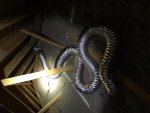Greg1707
Senior Member
- Location
- Alexandria, VA
- Occupation
- Business owner Electrical contractor
I purchased a Nutone exhaust fan today that specifies a six inch duct. I noticed the square hole in the side of the metal box was the same size as fans with four inch ducts. The only difference was the plastic adapter that connects between the square hole and the round duct was six inches in diameter instead of the usual four inches. So instead of the four inch square to four inch round there is a four inch square to six inch round.
I wonder how much more air can flow through a four inch square hole if there is a six inch pipe on the other side rather than a four inch pipe?
Can anyone do the math?
I wonder how much more air can flow through a four inch square hole if there is a six inch pipe on the other side rather than a four inch pipe?
Can anyone do the math?



